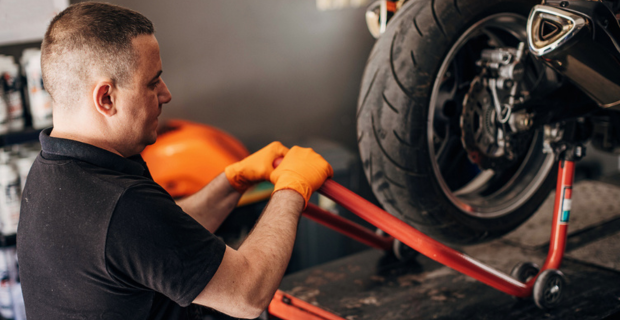Date Published: 2024/01/25
Read Time: mins
Prepare for spring with a new year checklist for your motorcycle

If you own one of Canada’s 829,892 registered motorcycles, you’re probably eager to hit the open road. But winter weather is still in full force. Thankfully, now’s the ideal time to ensure your bike is safe and ready for riding season. Follow this New Year checklist for motorcycle riding as you prepare for spring.
Remove pests
Mice, bugs, and other critters might escape the cold by nesting in your motorcycle’s airbox and exhaust. Carefully check these features and remove any pests. You can also replace the air filter if it’s damp from winter moisture.
Change the fluids
Oil, coolant, brake, fork, fuel, and other fluids keep your motorcycle moving. Unfortunately, fluids can oxidise or otherwise degrade as winter temperatures fluctuate. Check for sludge, cloudiness, and other changes in consistency and colour. Then, replace the fluids, filters, seals, and hoses as needed.
Lubricate moving parts
Your bike’s chain or belt might need degreased or replaced if it shows cracks or other signs of wear. And tighten the tension according to the manufacturer’s recommendations. Also, lubricate the chain or belt plus the clutch and throttle cables so that each part moves smoothly.
Test the brakes
Your motorcycle’s brakes could corrode if they get wet or seize after being in storage. So, visually inspect the entire system, including front and rear brakes plus pads. And walk your bike to ensure the brakes work properly.
Charge the battery
Cold weather can drain your bike’s battery and corrode terminals, posts, and cables. Inspect the battery for damage. If it appears intact, clean the terminals, secure the cables, and use a multimetre to verify the voltage. Then, charge the battery. If the battery is damaged or still doesn’t work after it’s charged, replace it.
Inflate the tires
Ensure your motorcycle retains contact with the road when you maintain the tires and wheels. Start by inspecting the tires for sidewall cracks, cuts, and punctures plus tread wear. Likewise, verify the wheel rims are free of dents, cracks, and buckles. You can then replace damaged parts if necessary. Tighten the spokes and nuts too. Finally, properly inflate the tires according to the manufacturer’s recommendation and align the wheels.
Turn on the electrical system
Your motorcycle might feature multiple electrical components designed for safety and functionality. Turn on your bike and test all these components, including the ignition, headlights, taillights, running lights, hazards, turn signals, gauge cluster, phone charger, and media system. Replace damaged, broken, or worn cables, fuses, and bulbs. Stock extra supplies for the riding season, too.
Start the engine
Even though you can’t ride in winter, turn your bike on. This maintenance tip keeps the fluids flowing and can charge the battery. Plus, you can verify the suspension and other components work properly.
Sit on Your bike
Now that your motorcycle is in good working condition, take a seat. Check that the handlebars are positioned properly and that you can easily steer your bike. Also, arrange the mirrors and make sure the shifter and brake pedal are comfortably situated.
Stock the right gear
Preparing your bike for your next ride is important, but remember your gear too since it can prevent injuries and help you stay comfortable. Try on your jacket, pants, boots, gloves, and helmet to ensure everything fits properly. Wash or wipe down each item, too. If your helmet is cracked, worn, or older than five years, replace it. Likewise, replace any worn gear, including your tank or duffel bag.
Condition your body
As you prioritise bike maintenance, prepare your body for the rigours of riding. Lunges, squats, pullups, biking, and running could improve your strength, flexibility, balance, and endurance. Fuel your body with a balanced diet, too, so you’re ready to operate your bike safely all season.
Update your riding skills
Whether you’re a novice or an expert rider, consider reviewing fundamentals and learning new skills like hand signals. You could also take a rider training course as you update or improve your skills and techniques.
Schedule your yirst ride
Gather your riding buddies and plan your first spring ride. Explore local roads, take a cross-country road trip, or plan a camping excursion. Whatever route you select, request a motorcycle insurance quote from Orbit. Update this essential coverage today as part of your New Year checklist for motorcycle riding.